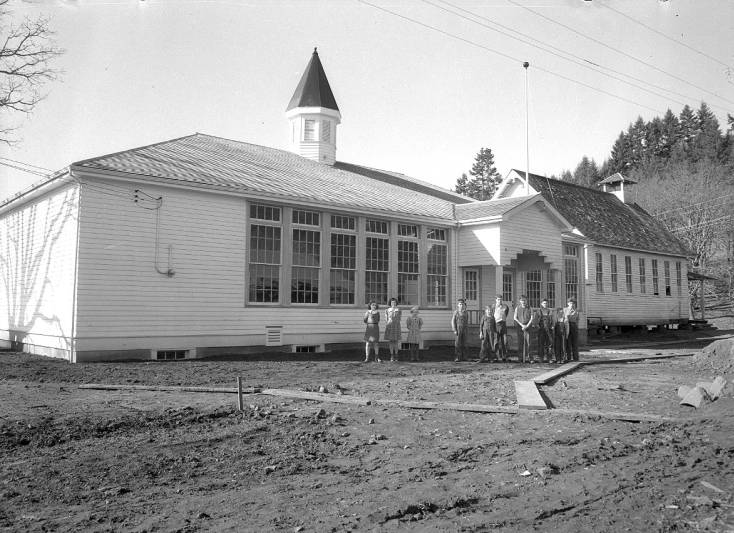As the city of Salem goes through its historic Ben Maxwell photo collection, Kimberli Fitzgerald, Salem’s historic preservation officer, is reviewing the text accompanying photos and sharing her findings with readers.
The caption for this photo states that is of the Eola School, constructed in 1858. However, I discovered that this was not a picture of the Eola School at all.
This particular photo and caption were exceptionally challenging for me to verify with the information and sources that I have on hand here at the city of Salem. I initially thought it would be pretty straightforward, especially since we have multiple photos in the Ben Maxwell collection which reference the Eola School in Eola, Oregon.
The first photo I looked at is Maxwell photo ID #4071 with the photo titled: “Students and teachers of the Eola School in Eola, Oregon, 1850s.” It surprised me upon closer inspection, that the building in this photo did not clearly appear to be the same structure that is in the later photos of the Eola School (Maxwell photo #s 4072 and 4073).
I knew that there were at least three different Eola school buildings, so initially I wondered whether this could have in fact been a picture of the first school, the earlier Cincinnati School in use prior to 1858, which I had read was actually also a residence, but this seemed unlikely, given the large number of students in the photo, and the name of the photography studio Catterlin & Lussier, who hadn’t established their studio until 1889.
I was finally able to confirm (with the help of my colleagues at the Willamette Heritage Center), that this picture is in fact of the original Brush College Schoolhouse, constructed in 1860 and not the Eola School. You can see this photo and read some interesting information about this school’s name here. The current Brush College Elementary School located at 2623 Doaks Ferry Rd N.W. in Salem.
In 1957 the Marion County National Education Association Centennial Committee published “100 Years of Progress in Education in Marion County,” which highlighted the history of 72 schools in Salem and the surrounding vicinity. This history included a history of Brush College school which described the school’s construction:
School district 31 was organized in 1860. At this time residents erected a one-room 25’ by 30’ school on the present site. Lumber was brought from nearby Eola Hills and the construction is credited to “Breeze” Gibson, John W. Harritt and Daniel Emmett. The unusual name of Brush College is often a matter of debate in reference to its origin…the school was called “College” in deference to the fact that it was the center of the highest learning available to the pioneer children in the area. “Brush” is characteristic of the ground cover surrounding the adjacent area. Indians were accustomed to annually burning the brush to facilitate hunting. The pioneers, mainly interested in farming, had allowed the brush to grow. It was, then, truly, a school out in the brush.

I was still interested in confirming the historical information associated with the remaining Maxwell photos of Eola School in our collection. Located three miles west of Salem, along the Willamette River, the community of Eola was near the river’s confluence with Rickreall Creek. Shaw founded the area in 1844 and originally named it Cincinnati, after his hometown in Ohio. Shaw had brought his flock of 25 merino sheep over the Oregon Trail in 1844 and was sometimes known as Joshua “Sheep” Shaw. While the town of Cincinnati was originally platted in 1849 in this location, it was moved to higher ground due to flooding.
By 1851 the town of Cincinnati had developed with a number of stores and businesses, and Abigail Scott taught at the first school in Cincinnati in 1853, which was originally located within a private residence, although I was not able to confirm its location. The Scotts had traveled to the Oregon Territory with their nine children in 1852, including 17-year-old Abigail. In her first year teaching in Cincinnati, Oregon, she met Benjamin Duniway, who she married in August 1853. They later moved to Ben’s donation land claim in Clackamas County and Abigail went on to campaign for women’s suffrage.
In 1855 the community’s name was changed to Eola by a local music teacher who was fond of harps (after an Aeolian harp), and the name was formally adopted by the Oregon Territorial Legislature when it was incorporated in 1856. Due to the picturesque location of this community, the site was even one of the locations considered by the Territorial Legislature as a site for Oregon’s Capitol Building.
In the May 5, 1934 Capitol Journal, a “Pioneer Picnic” was advertised at the Eola School, where a bronze plaque dedicated to the “Pioneers of Eola: 1856-1934” would be set in a boulder located in front of the school building. Speakers including George H. Hines, secretary of the Oregon Pioneer Association and Thomas Brunk, alumnus of the Eola School.
Ben Maxwell wrote an article about the construction of a new addition to the Eola School in the May 25, 1937 Capital Journal titled: “Oldest Oregon School In Operation Doomed; 79 Years in Service.” Maxwell wrote somewhat dramatically about the construction of the new schoolhouse, which at the time was anticipated to replace the original school building.
Maxwell summarized the history of the school, explaining that James and Nancy Clark deeded a lot to the county for a school site on February 1, 1858, for $35, and construction of the school began in the summer of 1858. The school was originally funded by fees paid by families to pay for their teacher. Fees were originally $3 a quarter term, until the first county taxes were levied, and it became a public school.

Eola School’s first teacher was James L. Gwin, who conducted classes from 1858 to 1861. Maxwell relayed the recollections of Thomas Brunk, who in 1937 was the oldest living alumnus of Eola School. He entered first grade in 1865 and remembered that David Holmes was his first teacher.
Brunk further recalled an incident that occurred when Ed Ingalls was his teacher in the late 1860s:
Billy Hayden was in school then and he was one of Ed’s most troublesome pupils. One morning Ed yanked Billy out of his seat and hauled him up in front of the class to give him a trouncing for deliberately dragging mud into the schoolroom on his brogans … Estella Hayden was Billy’s sister and a bit younger than he. She watched the scuffle with amused indifference until it appeared that her brother was in for the whaling of his life. Then, with the ferocity of a wildcat, she picked up a heavy slate and sprang from her seat. Maybe she aimed to hit Ed with the edge of the slate and send him spinning. But she missed and the slated came down flat on Ingall’s head with an awful clatter… school and Ingalls were soon out for the day.
Interestingly enough Ben Maxwell relayed a slightly different version of this story in his May 28, 1958 Capitol Journal article, referring to Jim Gwin as the teacher who tussled with Billy instead of Ed Ingalls.
Maxwell explained that the new Eola WPA schoolhouse addition, costing $12,000, would have two classrooms, a heating plant, inside plumbing and automatic light control, “refinements not contemplated by the pioneers when they built the existing Eola School 79 years ago.” A follow up photo published on March 6, 1938, (Ben Maxwell collection photo #4078) in the Oregon Statesman featured the new school.

It is not clear exactly when the original 1858 structure was removed or demolished. Most likely it was moved in the late 1950s or early 1960s when Northwest Second Street was constructed. This structure would have been in the path of the street, which was constructed in order to provide access to new residences built along the street in the 1960s, just to the south of this site.
It is especially interesting to note that in the August 28, 1971 Capital Journal, Karl Van Zandt wrote the following:
I was reading the Call for Action column in the August 23, Capital Journal about the old Cincinnati School, now Eola. I go to the Eola School in the sixth grade and my teacher, Mrs. Dorothy Suing, told us that the old schoolhouse was moved to the next block over, Riggs Street. It is still there, and I looked inside of it and there are two rooms and a hall. It is in bad shape, with moss growing on the roof. There is a stone with a name that has a date 1858 on it and it is down by the Eola School behind some bushes. I just thought you might be interested to know that the old Cincinnati School is still standing.
I would be really interested to know what may have happened to this structure!
The school was initially closed by the district in 1982. The Polk County Central School Board cited “fiscal responsibility to the voters” in making their decision. It was rented as a church until 1991 when the District opened the Eola Alternative School in the Eola school building. In a 2002 Oregon Statesman article, Forrest Bell superintendent of the Central School District, said that even though the cost per student is twice that at Central High School, it is worth it because the value is profound to the students who are benefiting from their education there. Unfortunately, the Eola Alternative School closed in 2003 due to lack of funds in the district. The 1938 building is still standing at Second and Mill Streets in Salem, just north of Highway 22. The building is currently occupied by the Word in Fellowship Church.
To learn more about the history of the community of Eola (Cincinatti), please visit oregonencylopedia.org and check out the article by Ted Dethlefs.
The Ben Maxwell Collection consists of more than 5000 photographs donated to the Salem Public Library by the estate of Mr. Ben Maxwell, a noted Salem photographer and historian who died in 1967. Maxwell was a native of Salem, where he was born in 1898. He attended college at Oregon State University where he studied history and journalism. He started working with the Capital Journal newspaper in 1939. Because he packed his camera on every quest for historical stories, he was able to illustrate his articles for readers of the Capital Journal, the Oregon Journal, the Oregonian, and several magazines.
He recorded on film at least 13 governors, old-timers now gone, covered bridges now missing, and buildings and homes no longer standing. The collection includes copies of rare early Oregon photographs taken by others which have in turn been copied over and over by later researchers and feature story writers. This collection is a work in progress and many additional photographs remain to be scanned. The collection can be accessed at: https://photos.salemhistory.net/digital/collection/max
The City of Salem’s Historic Preservation Program staff within the Community Development Department in collaboration with the Salem Historic Landmarks Commission are in the process of completing an inventory of this collection and working to confirm and verify the content and narratives associated with all the photographs in this collection. Please contact Salem’s Historic Preservation Officer, Kimberli Fitzgerald at [email protected] with any suggestions, historic facts, or questions you might have about these historic photos.
STORY TIP OR IDEA? Send an email to Salem Reporter’s news team: [email protected].
SUPPORT OUR WORK – We depend on subscribers for resources to report on Salem with care and depth, fairness and accuracy. Subscribe today to get our daily newsletters and more. Click I want to subscribe!
Kimberli Fitzgerald is the city of Salem's archeologist and historic preservation officer. She is a regular contributor to Salem Reporter's local history column.









